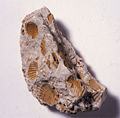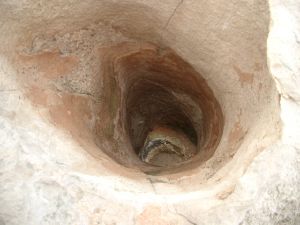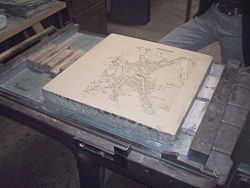Difference between revisions of "Limestone" - New World Encyclopedia
(imported latest version of article from Wikipedia) |
|||
| Line 1: | Line 1: | ||
| − | + | [[Image:Limestoneshale7342.JPG|frame|right|Limey shale overlaid by limestone, in Cumberland Plateau, Tennessee.]] | |
| − | [[ | + | '''Limestone''' is a [[Rock (geology)|sedimentary rock]] composed largely of the [[mineral]] [[calcite]]* (calcium carbonate, CaCO<sub>3</sub>). It makes up about 10 percent of the total volume of all sedimentary rocks. Limestones often contain variable amounts of silica in the form of [[chert]]* or [[flint]], as well as varying amounts of [[clay]], [[silt]], and [[sand]] as disseminations, nodules, or layers within the rock. |
| − | + | The calcite in limestone is produced mainly by [[marine biology|marine organisms]]. These organisms secrete shells that settle out of the water column and are deposited on [[ocean]] floors or are conglomerated in a coral reef. Secondary calcite may also be deposited by [[Supersaturation|supersaturated]] [[Meteorology|meteoric]] waters ([[groundwater]] that [[Precipitation (chemistry)|precipitates]]* the material in [[cave]]s). This produces [[speleothem]]s such as [[stalagmite]]*s and [[stalactite]]*s. Another form taken by calcite is that of [[oolite]]s (oolitic limestone), which can be recognized by its granular appearance. | |
Pure limestones are white or almost white. Because of impurities, such as [[clay]], sand, organic remains, [[iron oxide]] and other materials, many limestones exhibit different colors, especially on [[Weathering|weathered]] surfaces. Limestone may be crystalline, clastic, granular, or massive, depending on the method of formation. Crystals of calcite, [[quartz]], [[dolomite]] or [[barite]] may line small cavities in the rock. [[Folk classification|Folk]] and [[Dunham classification|Dunham]] classifications are used to describe limestones more precisely. | Pure limestones are white or almost white. Because of impurities, such as [[clay]], sand, organic remains, [[iron oxide]] and other materials, many limestones exhibit different colors, especially on [[Weathering|weathered]] surfaces. Limestone may be crystalline, clastic, granular, or massive, depending on the method of formation. Crystals of calcite, [[quartz]], [[dolomite]] or [[barite]] may line small cavities in the rock. [[Folk classification|Folk]] and [[Dunham classification|Dunham]] classifications are used to describe limestones more precisely. | ||
| Line 46: | Line 46: | ||
== See also == | == See also == | ||
| − | + | ||
| − | |||
| − | |||
| − | |||
| − | |||
| − | |||
* [[Calcite]] | * [[Calcite]] | ||
* [[Calcium Carbonate]] | * [[Calcium Carbonate]] | ||
| Line 57: | Line 52: | ||
* [[Coral sand]] | * [[Coral sand]] | ||
* [[Dolomite]] | * [[Dolomite]] | ||
| − | |||
| − | |||
* [[Marble]] | * [[Marble]] | ||
| − | |||
* [[Portland Limestone]] | * [[Portland Limestone]] | ||
* [[Quicklime]] | * [[Quicklime]] | ||
| − | |||
* [[Quarry]] | * [[Quarry]] | ||
| − | [[Category: | + | [[Category:Physical sciences]] |
| − | [[Category: | + | [[Category:Earth sciences]] |
| − | + | {{credit|70842763}} | |
| − | |||
| − | |||
| − | |||
| − | |||
| − | |||
| − | |||
| − | |||
| − | |||
| − | |||
| − | |||
| − | |||
| − | |||
| − | |||
| − | |||
| − | |||
| − | |||
| − | |||
| − | |||
| − | |||
| − | |||
| − | |||
| − | |||
| − | |||
| − | |||
| − | |||
| − | |||
| − | |||
| − | |||
| − | |||
| − | |||
| − | |||
| − | |||
| − | |||
Revision as of 20:50, 23 August 2006
Limestone is a sedimentary rock composed largely of the mineral calcite (calcium carbonate, CaCO3). It makes up about 10 percent of the total volume of all sedimentary rocks. Limestones often contain variable amounts of silica in the form of chert or flint, as well as varying amounts of clay, silt, and sand as disseminations, nodules, or layers within the rock.
The calcite in limestone is produced mainly by marine organisms. These organisms secrete shells that settle out of the water column and are deposited on ocean floors or are conglomerated in a coral reef. Secondary calcite may also be deposited by supersaturated meteoric waters (groundwater that precipitates the material in caves). This produces speleothems such as stalagmites and stalactites. Another form taken by calcite is that of oolites (oolitic limestone), which can be recognized by its granular appearance.
Pure limestones are white or almost white. Because of impurities, such as clay, sand, organic remains, iron oxide and other materials, many limestones exhibit different colors, especially on weathered surfaces. Limestone may be crystalline, clastic, granular, or massive, depending on the method of formation. Crystals of calcite, quartz, dolomite or barite may line small cavities in the rock. Folk and Dunham classifications are used to describe limestones more precisely.
Travertine is a banded, compact variety of limestone formed along streams, particularly where there are waterfalls and around hot or cold springs. Calcium carbonate is deposited where evaporation of the water leaves a solution that is supersaturated with chemical constituents of calcite. Tufa, a porous or cellular variety of travertine, is found near waterfalls. Coquina is a poorly consolidated limestone composed of pieces of coral or shells.
During regional metamorphism that occurs during the mountain building process (orogeny) limestone recrystallizes into marble.
Limestone is a parent material of Mollisol soil group.
Limestone with bivalve fossils
Various fossils collected from a limestone quarry, North Carolina USA. Clockwise from upper left: echinoids, bryozoans, and brachiopods
Water cooled limestone saw, Belgium
Limestone landscape
Limestone is partially soluble, especially in acid, and therefore forms many erosion landforms. These include limestone pavements, pot holes, cenotes, caves and gorges. Such erosion landscapes are known as karsts. Limestone is less resistant than most igneous rocks, but more resistant than most other sedimentary rocks. Limestone is therefore usually associated with hills and downland and occurs in regions with other sedimentary rocks, typically clays.
Bands of limestone emerge from the Earth's surface in often spectacular rocky outcrops and islands. Examples include the Burren in Co. Clare, Ireland; the Verdon Gorge in France; Malham Cove in North Yorkshire, England; on Fårö near the Swedish island of Gotland, the Niagara Escarpment in Canada/USA, Notch Peak in Utah, and the Ha Long Bay National Park in Vietnam.
In Belgium and Holland there are several huge quarries, with a total gallery length of more than a hundred kilometers. An example of a hill with a lot of quarries is mount Saint Peter (Belgium/Netherlands) [1].
Uses of limestone
Limestone is especially popular in architecture, and many landmarks around the world, especially in North America and Europe, are made primarily of the material. So many buildings in Kingston, Ontario, Canada were constructed from it, that it was nicknamed the 'Limestone City'. Limestone is readily available and relatively easy to cut into blocks or more elaborate carving. It is also long-lasting and stands up well to exposure. However, it is a very heavy material, making it impractical for tall buildings. It is also quite expensive.
Limestone was most popular in the early 20th and late 19th centuries. Train stations, banks and other structures from that era are normally made of limestone. Limestone is used as a facade on some skyscrapers, but only in thin plates for covering rather than solid blocks. In the United States, Indiana has long been noted as a source of high quality quarried building Indiana limestone, while many famous buildings in London are built from Portland limestone.
Limestone was also a very popular building block in the middle ages in the areas where it occurred since it is hard, durable, and commonly occurs in easily accessible surface exposures. Many medieval churches and castles in Europe are made of limestone.
Limestone and marble are very reactive to acid solutions, making acid rain a significant problem. Many limestone statues and building surfaces have suffered severe damage due to acid rain.
Other uses include:
- the manufacture of quicklime (calcium oxide)and slaked lime (calcium hydroxide)
- cement and mortar
- pulverized limestone is used as a soil conditioner to neutralize acid soil conditions
- crushed for use as aggregate - the solid base for many roads
- geological formations of limestone are among the best petroleum reservoirs
See also
Credits
New World Encyclopedia writers and editors rewrote and completed the Wikipedia article in accordance with New World Encyclopedia standards. This article abides by terms of the Creative Commons CC-by-sa 3.0 License (CC-by-sa), which may be used and disseminated with proper attribution. Credit is due under the terms of this license that can reference both the New World Encyclopedia contributors and the selfless volunteer contributors of the Wikimedia Foundation. To cite this article click here for a list of acceptable citing formats.The history of earlier contributions by wikipedians is accessible to researchers here:
The history of this article since it was imported to New World Encyclopedia:
Note: Some restrictions may apply to use of individual images which are separately licensed.





